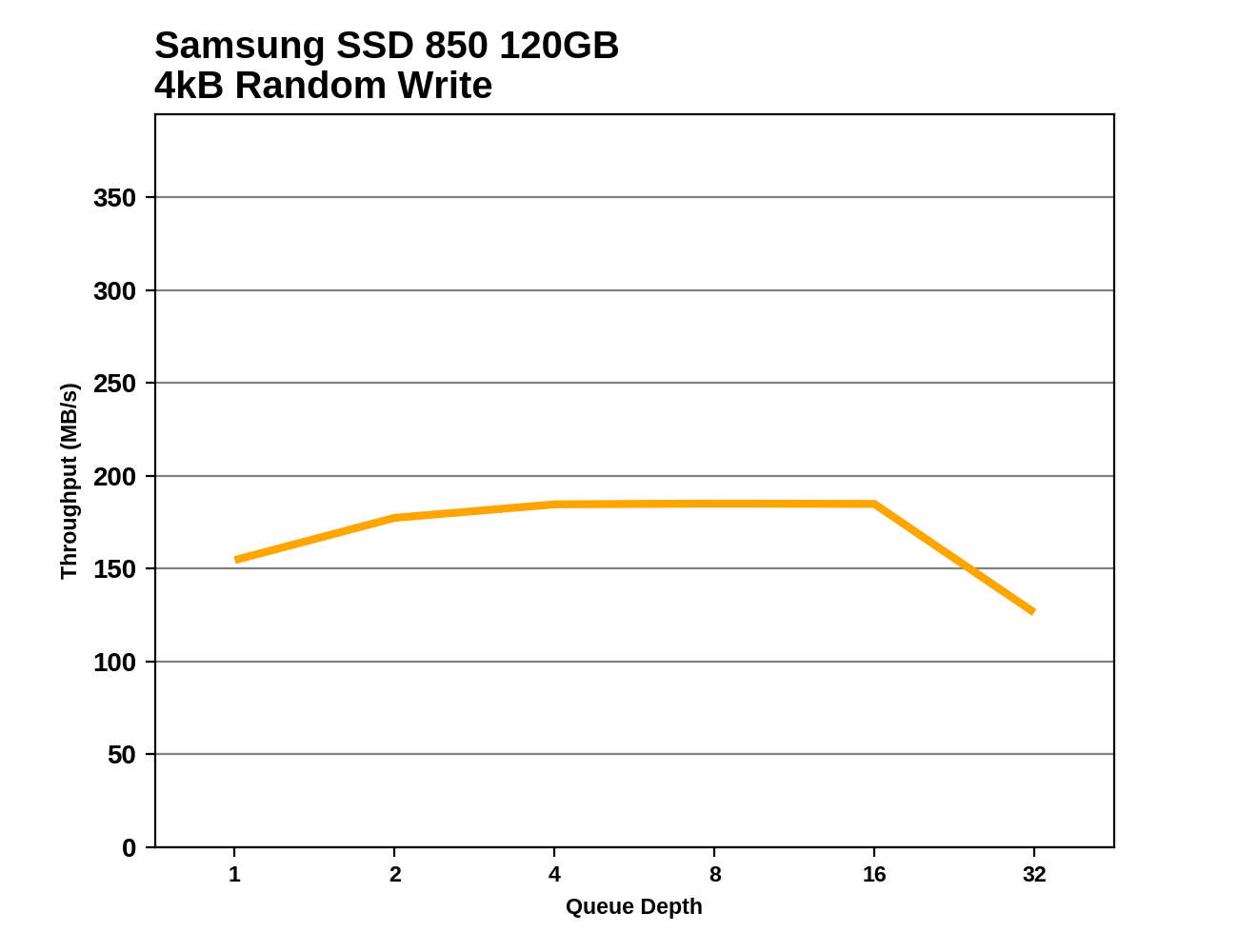The Samsung SSD 850 120GB Review: A Little TLC for SATA
by Billy Tallis on November 27, 2017 12:00 PM ESTRandom Read Performance
Our first test of random read performance uses very short bursts of operations issued one at a time with no queuing. The drives are given enough idle time between bursts to yield an overall duty cycle of 20%, so thermal throttling is impossible. Each burst consists of a total of 32MB of 4kB random reads, from a 16GB span of the disk. The total data read is 1GB.

The Samsung SSD 850 120GB has a significantly slower random read speed than its predecessors from Samsung, but it is still faster than any other brand. The Micron 3D TLC-based SSDs that are actually currently for sale are the three slowest drives on this test.
Our sustained random read performance is similar to the random read test from our 2015 test suite: queue depths from 1 to 32 are tested, and the average performance and power efficiency across QD1, QD2 and QD4 are reported as the primary scores. Each queue depth is tested for one minute or 32GB of data transferred, whichever is shorter. After each queue depth is tested, the drive is given up to one minute to cool off so that the higher queue depths are unlikely to be affected by accumulated heat build-up. The individual read operations are again 4kB, and cover a 64GB span of the drive.

On the longer random read test that brings in higher queue depths, the rankings are almost unchanged. The 850 120GB is Samsung's slowest, but everyone else is much slower.
 |
|||||||||
At higher queue depths, the Samsung drives scale up to much higher performance levels than the competing 120GB-class SSDs. The 850 is still the slowest of Samsung's drives and it falls short by more than 100MB/s at QD16 and higher, but by that point the 850 is 2.5 times faster than the quickest Micron 3D TLC-based drive.
Random Write Performance
Our test of random write burst performance is structured similarly to the random read burst test, but each burst is only 4MB and the total test length is 128MB. The 4kB random write operations are distributed over a 16GB span of the drive, and the operations are issued one at a time with no queuing.

There aren't huge disparities between the 120GB-class SSDs on the burst random write test, save for the DRAMless HP S700. The Samsung SSD 850 is only slightly slower than the old 850 EVO, but two of the drives using Micron 3D TLC come out on top for this test.
As with the sustained random read test, our sustained 4kB random write test runs for up to one minute or 32GB per queue depth, covering a 64GB span of the drive and giving the drive up to 1 minute of idle time between queue depths to allow for write caches to be flushed and for the drive to cool down.

With a longer test duration that will tend to fill the whatever SLC write cache such a small drive can include, the old Samsung 850 PRO 128GB is unsurprisingly the winner by a wide margin. The Samsung 850 comes in second place and slightly ahead of the old 850 EVO, somewhat corroborating Samsung's claims that their 64L 3D TLC offers improved write performance.
 |
|||||||||
The performance of the Samsung 850 holds up through most of the random write test, but doesn't improve significantly as queue depths grow. By the end of the test, the drive has fallen behind on garbage collection despite the idle time it is allowed between queue depths, and performance drops off. Most of the other drives suffer a similar fate at some point during the test; the 750 EVO is the fastest drive that doesn't show a precipitous drop at any point. The Samsung 850 PRO was still faster than the rest even after its spare area was filled and it was forced to perform garbage collection through the later parts of the test.










31 Comments
View All Comments
boozed - Monday, November 27, 2017 - link
This website really needs a "send corrections" link...mr_tawan - Tuesday, November 28, 2017 - link
corrections is a kind of participation. Using comments is not that bad idea.dgingeri - Monday, November 27, 2017 - link
This sounds like a great OS drive for servers. They don't change all that much, especially if the logs are offloaded to a different drive.sonny73n - Tuesday, November 28, 2017 - link
TLC for servers? No thanks.dgingeri - Wednesday, November 29, 2017 - link
Why not? Write endurance is not a factor when dealing with the boot/OS drive, especially when logs are moved onto another drive. Most servers would see 10-15GB of writes per week on the OS drive, with updates bumping that up more once in a while. This drive would last for decades at that write level.tmanini - Tuesday, November 28, 2017 - link
meh - while there is nothing wrong with one as a boot drive only: once booted you won't benefit much. (this is not a reflection for complex server environs - which then you would never consider this SSD as a contender)lilmoe - Monday, November 27, 2017 - link
The EVOs are priced down on amazon now. Just saying.Magichands8 - Monday, November 27, 2017 - link
They better be. Nothing much to see here.lilmoe - Monday, November 27, 2017 - link
I know... I like Sammy and all, but I'd like to see them go even lower. 2TB SSDs shouldn't be a luxury anymore.mapesdhs - Wednesday, November 29, 2017 - link
Still a very long way from where they used to be. 850 EVO 250GB is currently 85 UKP on Amazon; before the pricing went crazy it was 53 UKP.